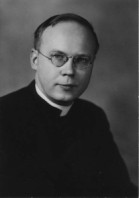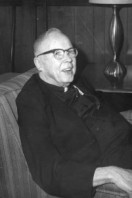I repeat, with pride and admiration for the subject, earlier posts that I wrote for Monsignor John J. Doyle. It is hard to believe that so many years have passed since his death. In addition to the previous posts below, I also include the text of an article that taken from The 1967 Marian College (Alumni) Newsletter. Read this slowly and you will see the type of man that John Doyle was, what kind of priest that he was.
Three-Wing Dorm Dedicated:
The Men’s Residence Center was dedicated and officially named Doyle Hall on May 17. In attendance at the ceremony were students, faculty and friends of the college Officiating at the dedication were Archbishop Paul C. Schulte of Indianapolis. Msgr. Francis J. Reine. Tom Turner, Student Board President. Chuck Calleia. President of Doyle Hall, and Msgr. John J. Doyle. Chairman of the Philosophy Department and mentor to all students of Marian since its founding. The move to name the hall after Msgr. Doyle was inspired by an editorial in the student publication, the Carbon.
Msgr. Doyle gave a short address al the dedication which was typical of his unflagging wit and his enduring commitment as scholar and Christian. Here are a few excerpts from his talk
“A good many years ago. in Logan County, Ohio, when it was proposed to construct a new road that would take a strip off his farm, my grandfather Brennan strenuously opposed the measure, though he had long before retired and rented his farm. As usually happens the county authorities prevailed and the road was built. My grandfather was considerably mollified in his defeat when the new thoroughfare was given the name of Brennan Road. I cannot deny that it is very gratifying to me to have this beautiful building given the name of Doyle.”I do not wish to insinuate that my attitude toward this hall was a repetition of my grandfather’s opposition to the road. On the contrary, the transformation of Marian College from a women’s school to one that would accept both women and men was altogether in accordance with all that I believe in integration of women and men. of negroes and whites, of clergy and religious and laity, has for a long time been my dream, the Kingdom of God. in which there is no distinction of Jew and Greek, slave and free. This is what Saint Paul tells when he writes. “˜Here there cannot be Greek and Jew, circumcised and uncircumcised. barbarian. Scythian, slave, free man. but Christ is all, and in all.* ”Even in the earliest years of the college 30 years ago. there were happenings that by hindsight we might see to have been foreshadowing of the development of 1954. when the college became coeducational. So far as I know the first course given in what is now the library and was then the college was a class in French, of which four priests that were to go to the Catholic University the following September for graduate studies were the members and I was the teacher. I do not know* how good a teacher of French I was. but the priests achieved their Masters degrees, as they could not have done had they not previously passed the French examination. This occasion is all the more a happy one in that today, as Monsignor Reine has told you. is the anniversary of my ordination to the priesthood. Little did I dream on that Pentecost Tuesday 46 years ago that it should be my lot to spend the greater part of my life as a teacher: no more did I dream that I should one day be a judge of the ecclesiastical court. My uncle. Father John W. Doyle, who had died just eleven years previously, had been a parish priest throughout his 35 years in the ministry. 1 had looked forward to a similar life, and indeed for the first nine years I was an assistant and I should have been very happy to continue in parish work for the rest of my life. But there is a divinity that shapes our ends rough hew them how we may. In one of the first talks I gave to the 22 students that constituted the college in 1937, I made the point that they would establish the ideals, the aspiration, the traditions by which the college would live “” only indirectly could the priests, the sisters, and the other teachers contribute to this end. What I neglected in so saying was that such ideals and traditions are not made once for all; they are subject to constant change and growth and development. Hence it is not just what those first students handed down that has made the college what it is; it is those traditions as they have been affected by all the other students in the intervening years. And what the college will be in 1997 will be the result of all these have done and of what you students of 1967 do and think and work and perhaps most of all of how you pray.
It was Mr. Fields that showed me that editorial in the Carbon that suggested the name of Doyle Hall for your residence. I took the matter as a pleasant jest, making the somewhat frivolous objection that two monosyllables would not go well together for a name As time went on. I could not fail to become aware that this thing was said in deadly earnest and was no jest at all. Finally Monsignor Reine came to me with the cold proposal, which could not be sidestepped. Of course, I could not reject it. As I have thought about the matter, I have become convinced that this is not an honor done to me alone, but that it is aimed at all that have taught here – Monsignor Reine and the other priests; Mr. Fields and Miss Malatesta and the other teachers; Sister Gertrude Marie, who along with me constitutes the remnant of the original faculty of 1937. and the other sisters. I am by way of being a symbol for all of these, whereby the devotion and gratitude and respect of the students are shown to all that here seek to find and reveal the truth and to open up the way to the Kingdom of God. I am most happy to serve as such a symbol. I can say with a full heart the verse of the Psalm: My lines have fallen for me in pleasant places; yea, I have a goodly heritage

 May 17th marks the anniversary of the ordination of Monsignor John J. Doyle, for whom this website is dedicated. He died on March 22, 1985. Msgr. Doyle was born in Indianapolis on March 13, 1898. He attended St. Joseph’s Parish school, which was then located on the corner of North Street and College Avenue. He attended St. Meinrad seminary in southern Indiana and he was ordained on May 17, 1921. Msgr. Doyle, known to many as the “Mons” spent most of his priestly career as a professor at Marian College in Indianapolis. After his retirement, Monsignor Doyle became the Archivist and Historian of the Archdiocese of Indianapolis. He contributed much to the understanding of Indiana Catholic Church History. In 1976 he published “The Catholic Church in Indiana 1686-1814“. In 1978 he published “Genealogical Use of Catholic Records in North America” for the Indiana Historical Society. Msgr. Doyle’s love of history, especially his love of history of the Church in Indiana always showed through. These photos show him as a young priest and another from his 80th birthday. In his history of the earliest days of the Church in Indiana, mentioned above, Msgr. Doyle pays tribute to Father Robert Gorman who actually wrote a history of the diocese, but it was never published. Father Gorman died in 1964.
May 17th marks the anniversary of the ordination of Monsignor John J. Doyle, for whom this website is dedicated. He died on March 22, 1985. Msgr. Doyle was born in Indianapolis on March 13, 1898. He attended St. Joseph’s Parish school, which was then located on the corner of North Street and College Avenue. He attended St. Meinrad seminary in southern Indiana and he was ordained on May 17, 1921. Msgr. Doyle, known to many as the “Mons” spent most of his priestly career as a professor at Marian College in Indianapolis. After his retirement, Monsignor Doyle became the Archivist and Historian of the Archdiocese of Indianapolis. He contributed much to the understanding of Indiana Catholic Church History. In 1976 he published “The Catholic Church in Indiana 1686-1814“. In 1978 he published “Genealogical Use of Catholic Records in North America” for the Indiana Historical Society. Msgr. Doyle’s love of history, especially his love of history of the Church in Indiana always showed through. These photos show him as a young priest and another from his 80th birthday. In his history of the earliest days of the Church in Indiana, mentioned above, Msgr. Doyle pays tribute to Father Robert Gorman who actually wrote a history of the diocese, but it was never published. Father Gorman died in 1964.